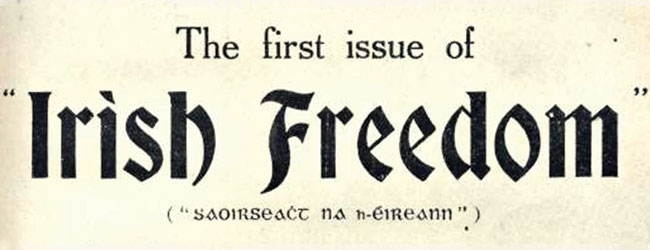28 October 2010
Remembering the Past | BY MÍCHEÁL Mac DONNCHA
Centenary of ‘Irish Freedom’ newspaper
 THE first decade and a half of the 20th century saw a flood of new publications including weekly and monthly journals and newspapers reflecting the political and cultural revival known as ‘Irish Ireland’. These papers reflected the rebirth of the Irish language, the growth of the labour movement, the emergence of feminism and the renewal of militant Irish republicanism.
THE first decade and a half of the 20th century saw a flood of new publications including weekly and monthly journals and newspapers reflecting the political and cultural revival known as ‘Irish Ireland’. These papers reflected the rebirth of the Irish language, the growth of the labour movement, the emergence of feminism and the renewal of militant Irish republicanism.
No single publication did more to pave the way for the 1916 Rising than the Irish Republican Brotherhood’s monthly journal, Irish Freedom. Those who wrote for, managed, distributed and sold the paper were among the foremost fighters in the Easter Rising and in the following revolutionary years. The paper had an influence far beyond its modest size.
In 1907, Thomas J. Clarke returned to Ireland from the United States. He had emigrated there after having endured 15 horrific years in English prisons. He was unbroken by his ordeal and more determined than ever to fight for Irish independence. However, on his return to Ireland he found the Irish Republican Brotherhood in a poor state. An old guard was content to keep the flame alive and little more.
Tom Clarke soon made common cause with younger republicans such as Seán Mac Diarmada, Patrick McCartan, Bulmer Hobson, Denis McCullough and PS O’Hegarty.
Seán Mac Diarmada was national organiser of Sinn Féin as well as an IRB member. He played a key role in the first Sinn Féin parliamentary election contest in North Leitrim in 1908. He and Clarke formed a close friendship and worked to return the IRB to its revolutionary purpose.
PS O’Hegarty recalled that the starting of a new newspaper by the IRB was “wholly due to Tom” and that Irish Freedom “gave to the separatist movement in Ireland unity and philosophy”.
In October 1910, Tom Clarke wrote to his former prison comrade, the veteran Fenian John Daly of Limerick, that they would be starting a newspaper along the lines of the United Irishman. This was a paper backed by the IRB and edited by Arthur Griffith. By 1910, the younger republicans were leaving Sinn Féin because of Griffith’s inflexible attitude and his refusal to advance a stronger separatist position. Clarke told Daly that new paper would have some former United Irishman writers “Griffith excepted”.
The first issue of Irish Freedom appeared in November 1910 and nailed its colours to the mast. Its editorial stated:
“We stand not for an Irish party but for national tradition - the tradition of Wolfe Tone and Robert Emmet, of John Mitchel and John O’Leary. We stand for the complete and total separation of Ireland from England and the establishment of an Irish Government untrammelled and uncontrolled by any other government in the world.”
The Chief Commissioner of the Dublin Metropolitan Police, in a secret memo, said the paper represented “the most extreme section in this country”.
From the first, Irish Freedom asserted that Irish independence could not be won through the efforts of John Redmond’s Irish Party at Westminster. During the paper’s relatively brief existence, 1910 to 1914, the Irish Party was propping up the English Liberal Government and was increasingly subservient to it in order to ensure passage of the very limited Home Rule Bill. But as the Liberals crumbled before violent Tory/unionist opposition to Home Rule, Irish Freedom was the focus for building the alternative to what republicans saw as the corrupt politics of Redmondism.
With Bulmer Hobson as editor and Seán Mac Diarmada as manager, the paper became increasingly influential. Mac Diarmada was a popular figure who had contacts across Ireland from his time as a Sinn Féin organiser. Like Tom Clarke’s shop in Dublin’s Parnell Street, the Irish Freedom office in D’Olier Street (later the Irish Times office!) was a centre of revolutionary activity.
The paper attracted many talented writers.
The O’Rahilly in 1912 wrote a series on Irish military matters under the pen-name ‘Rapparee’. In the same year, Peadar Kearney’s ‘Soldier’s Song’ (‘Amhrán na bhFiann’) was first published in Irish Freedom. Pádraig Pearse wrote a series called ‘From a Hermitage’ and Terence Mac Swiney’s articles were ‘Principles of Freedom’. After much persuasion, Tom Clarke wrote a series on his time in English prisons - ‘Glimpses of an Irish Felon’s Prison Life’. The latter three series were later published as books.
There was debate in the pages of the paper on the Dublin Lock-Out of 1913, with Pearse and Éamonn Ceannt expressing sympathy for the locked-out workers.
Irish Freedom helped ensure that the IRB played a pivotal role in the founding of the Irish Volunteers in November of that year. With the outbreak of the Great War in August 1914, the paper’s days were numbered and it was suppressed by the British Government at the end of 1914.
• Irish Freedom was first published on November 15th 1910, 100 years ago this month.
Follow us on Facebook
An Phoblacht on Twitter
Uncomfortable Conversations

An initiative for dialogue
for reconciliation
— — — — — — —
Contributions from key figures in the churches, academia and wider civic society as well as senior republican figures




